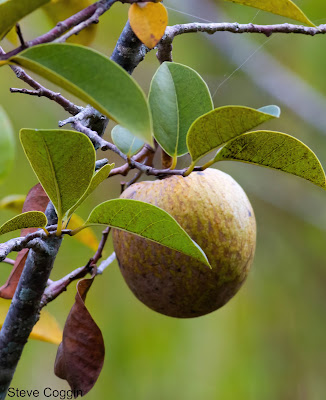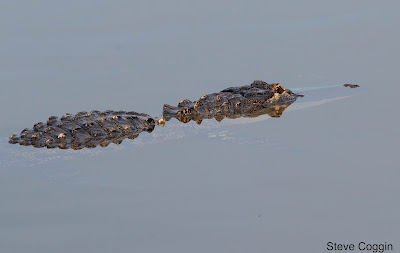 |
| Green Iguana (Iguana iguana). Green Cay Wetlands, Palm Beach County, Florida. |
Pond Apples are fruits made by the Pond Apple tree (Annona glabra). This tree is native to Florida, the American tropics and west Africa. True to the name, Pond Apples grow in swamps, beside lakes, along rivers and, yes, on the margins of ponds. Pond Apple trees are sensitive to cold and South Florida is the northern limit of their range in the North America. There was once a large forest of Pond Apples on the southern shore of Lake Okeechobee. This forest was lost with the coming of drainage canals and farms to that area. Pond Apple trees are favored nest sites for many wading birds in Florida. Wakodahatchee Wetlands in Palm Beach County has a large stand of Pond Apple trees that host nesting Wood Storks (Mycteria americana) and other impressive waders.
 |
| Wood Storks (Mycteria americana) nesting in a Pond Apple tree (Annona glabra). Wakodahatchee Wetlands, Palm Beach County, Florida. |
Pond Apple trees produce pale flowers in spring. The flower develops into the apple that grows throughout the summer, changing from green to yellow. The apples are 3-4 inches in diameter and look very much like the apples we eat.
 |
| Pond Apple (Annona glabra) flower bud. Wakodahatchee Wetlands, Palm Beach County, Florida. |
 |
| A young Pond Apple. Wakodahatchee Wetlands, Florida. |
When ripe, the apples fall from the tree, often into water where they float. The main way Pond Apple disperses it seeds is with its floating fruits. The fruit
can float for weeks and the seeds can even survive salt water immersion. Pond Apples fruits probably floated across the
Atlantic from South America to colonize Africa.
 |
| Mature Pond Apple fruit. Wakodahatchee Wetlands, Palm Beach County, Florida. |
Pond Apple fruits are edible, with yellow flesh and a mild taste. But the seeds are poisonous and their extracts were used as a fish poison by Native Americans. Pond Apple is important in traditional medicine and has been used to treat a variety of aliments including tubercular cough, intestinal worms and diarrhea.
 |
| American Alligator (Alligator mississippiensis). This gator is hunting Pond Apples. Green Cay Wetlands, Palm Beach County, Florida. |
 |
| Florida Red-bellied Cooter (Pseudemys nelsoni) eating a floating Pond Apple. Wakodahatchee Wetlands, Palm Beach County, Florida. |
 |
| Green Iguanas feasting on a Pond Apple. Wakodahatchee Wetlands, Palm Beach County, Florida. |
Pond Apples thrive in south Florida and other tropical
areas. The fruits and the trees are salt tolerant
so they are better equipped than many plants for climate change induced sea-level rise. Pond Apples will
continue thrive in Florida and feed the reptiles.
No comments:
Post a Comment